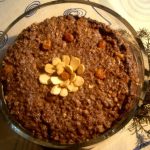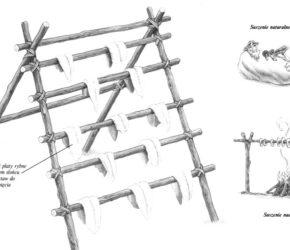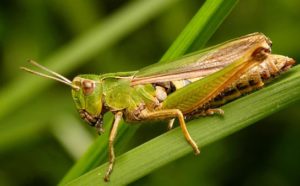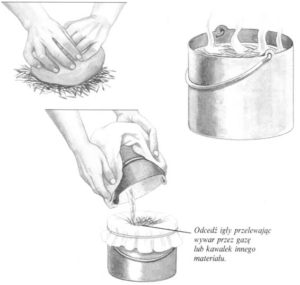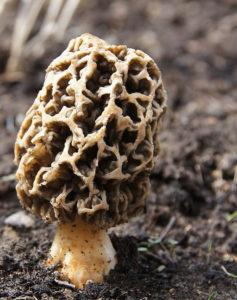Orzechy i owoce są podstawowym źródłem naturalnego pożywienia człowieka w terenie. W strefie umiarkowanej owoce pojawiają się w połowie lata, a orzechy późnym latem i jesienią. Większość owoców rosnących na dziko trudno jest przechowywać. Niektóre z nich można ususzyć, z pewnych przygotować dżemy czy inne przetwory. Zbierając dziko rosnące owoce czy orzechy należy pamiętać, że odżywiają się nimi także ptaki i ssaki. Dotyczy to zwłaszcza orzechów, z których zwierzęta robią zapasy na zimę. W żadnym wypadku nie jedz owoców i orzechów przejrzałych lub nadgniłych, gdyż mogą wywołać poważne dolegliwości.
ORZECHY JADALNE
Orzechy są bogatym źródłem białka i tłuszczu. Z niektórych szczególnie bogatych w tłuszcz, jak na przykład z orzeszków bukowych, można pozyskiwać olej i używać go później do gotowania lub smażenia. W tym celu orzechy trzeba dość długo gotować w wodzie na wolnym ogniu, a potem zebrać tłuszcz.
Orzechy zaś można zetrzeć na mąkę. Łatwo się je przechowuje. Doskonałe są jako wysokokaloryczny prowiant na drogę.
Orzech włoski (Juglansregia)
Rośnie w klimacie umiarkowanym. Drzewo to ma charakterystyczną, guzowatą korę. Orzechy otoczone są zieloną, skórzastą okrywą, która obsycha i pęka. Nasiona orzecha włoskiego są bogatym źródłem kalorii.
Orzech laskowy
To owoc leszczyny fCorylusj, drzewa lub wysokiego krzewu rosnącego w krajach o klimacie umiarkowanym. Ta roślina ma liście jajowate lub okrągłe, ząbkowane, kwiatostany pręcikowe zebrane w długie brązowożółte kotki. Orzechy w liściastych okrywach mają kosmatą łupinę.
Pistacja (Pistacia)
Rośnie w Europie, Azji i Australii. Nasiona owoców – orzeszki pistacjowe, można jeść surowe lub prażone.
Kasztan jadalny (Castanea sativa)
Rośnie w krajach śródziemnomorskich, ma liście lancetowate o ząbkowanych brzegach i owoce (orzechy), zwane kasztanami, po 2-3 w kulistej miseczce z kolcami. Przed zjedzeniem kasztany trzeba obrać, a potem ugotować i utłuc, bądź upiec nad ogniskiem.
Orzechy odmiany leszczyny, orzesznika występującego powszechnie na wilgotnych obszarach w całej Ameryce Północnej zawierają więcej tłuszczu niż jakiekolwiek inne orzechy, owoce czy warzywa. Również orzechy Macadamii z Australii nadają się dojedzenia, chociaż na surowo nie są zbyt smaczne i najlepiej jeść prażone.
ORZECHY TRUJĄCE
Przed zjedzeniem orzecha należy zawsze się upewnić, czy nie jest trujący, stosując na przykład test smakowy. Oprócz trujących orzechów, których jest stosunkowo niewiele, występują również takie, których nie można jeść na surowo. Zawsze też należy unikać jedzenia orzechów nadgniłych bądź
spleśniałych. Jeśli jakikolwiek orzech ma słodkawy zapach przypominający migdały, nie jedz go, gdyż może zawierać silnie trujący kwas pruski.
Nerkowiec (Anacardium)
Orzechy tej rośliny są trujące, gdy jemy je na surowo. Nadają się do jedzenia dopiero po starannym obraniu i ugotowaniu. Gotując je trzeba bardzo uważać, gdyż wydzielana z nich para może spowodować ślepotę. Nerkowiec rośnie w ciepłych krajach.
Kasztanowiec (Aesculus)
Rośnie w strefie umiarkowanej, ma duże, dłoniaste liście, jasne kwiaty w stożkowatych wiechach rozwijające się z lepkich pąków. Niektóre odmiany kasztanowca mogą osiągać 30 m wysokości. Torebki nasienne są mniej kolczaste niż torebki kasztana jadalnego, a znajdujące się w nich nasiona, zwane popularnie kasztanami, znacznie większe od kasztanów jadalnych.
Nasiona migdałowca (Primus amygdalus), czyli migdały, chociaż jadalne, mogą zawierać kwas pruski i mieć gorzki smak. Żołędzie będące owocami dębu (Quercus) również są jadalne. Przed zjedzeniem trzeba je jednak moczyć przez kilka godzin w zimnej wodzie, a potem prażyć na ogniu, wówczas stracą swój gorzki smak.
.jpg)

